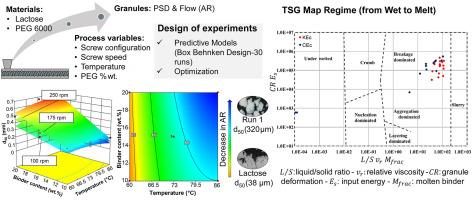A novel regime map for twin-screw melt granulation: Unveiling new insights into key operating variables
IF 4.3
2区 材料科学
Q2 ENGINEERING, CHEMICAL
引用次数: 0
Abstract
Regime maps are vital in twin-screw granulation, predicting outcomes via dimensionless numbers. This study develops a novel regime map for twin-screw melt granulation, adapting a wet granulation model. Using Design of Experiments, screw speed, screw configuration, temperature, and binder amount were optimized with lactose and PEG 6000. Results show how these variables impact on particle size and flowability. Optimal conditions (20 wt% PEG, 70 °C, 100 rpm) yielded granules with 0.360 mm median size and 6.67 % Carr Index, indicating excellent flow. Increased binder and kneading elements led to larger granules, while higher screw speed enhanced mixing. Elevated temperatures boosted binder melting. The regime map accurately categorized growth, largely in the breakage-dominated region, and was validated across systems, proving its predictive potential.

双螺杆熔体造粒的新制度图:揭示对关键操作变量的新见解
体制图是至关重要的双螺杆造粒,通过无因次数预测结果。本研究开发了一种新的双螺杆熔体造粒机制图,采用湿式造粒模型。采用实验设计法,以乳糖和PEG 6000为主要原料,对螺杆转速、螺杆构型、温度、粘结剂用量进行了优化。结果显示了这些变量对颗粒大小和流动性的影响。最佳条件(20 wt% PEG, 70°C, 100 rpm)产生的颗粒中位数尺寸为0.360 mm,卡尔指数为6.67%,表明流动性良好。增加粘结剂和捏合元素导致更大的颗粒,而更高的螺杆转速增强混合。高温促进了粘结剂的熔化。制度图准确地分类了生长,主要是在破碎为主的区域,并在各个系统中得到验证,证明了其预测潜力。
本文章由计算机程序翻译,如有差异,请以英文原文为准。
求助全文
约1分钟内获得全文
求助全文
来源期刊

Particuology
工程技术-材料科学:综合
CiteScore
6.70
自引率
2.90%
发文量
1730
审稿时长
32 days
期刊介绍:
The word ‘particuology’ was coined to parallel the discipline for the science and technology of particles.
Particuology is an interdisciplinary journal that publishes frontier research articles and critical reviews on the discovery, formulation and engineering of particulate materials, processes and systems. It especially welcomes contributions utilising advanced theoretical, modelling and measurement methods to enable the discovery and creation of new particulate materials, and the manufacturing of functional particulate-based products, such as sensors.
Papers are handled by Thematic Editors who oversee contributions from specific subject fields. These fields are classified into: Particle Synthesis and Modification; Particle Characterization and Measurement; Granular Systems and Bulk Solids Technology; Fluidization and Particle-Fluid Systems; Aerosols; and Applications of Particle Technology.
Key topics concerning the creation and processing of particulates include:
-Modelling and simulation of particle formation, collective behaviour of particles and systems for particle production over a broad spectrum of length scales
-Mining of experimental data for particle synthesis and surface properties to facilitate the creation of new materials and processes
-Particle design and preparation including controlled response and sensing functionalities in formation, delivery systems and biological systems, etc.
-Experimental and computational methods for visualization and analysis of particulate system.
These topics are broadly relevant to the production of materials, pharmaceuticals and food, and to the conversion of energy resources to fuels and protection of the environment.
 求助内容:
求助内容: 应助结果提醒方式:
应助结果提醒方式:


